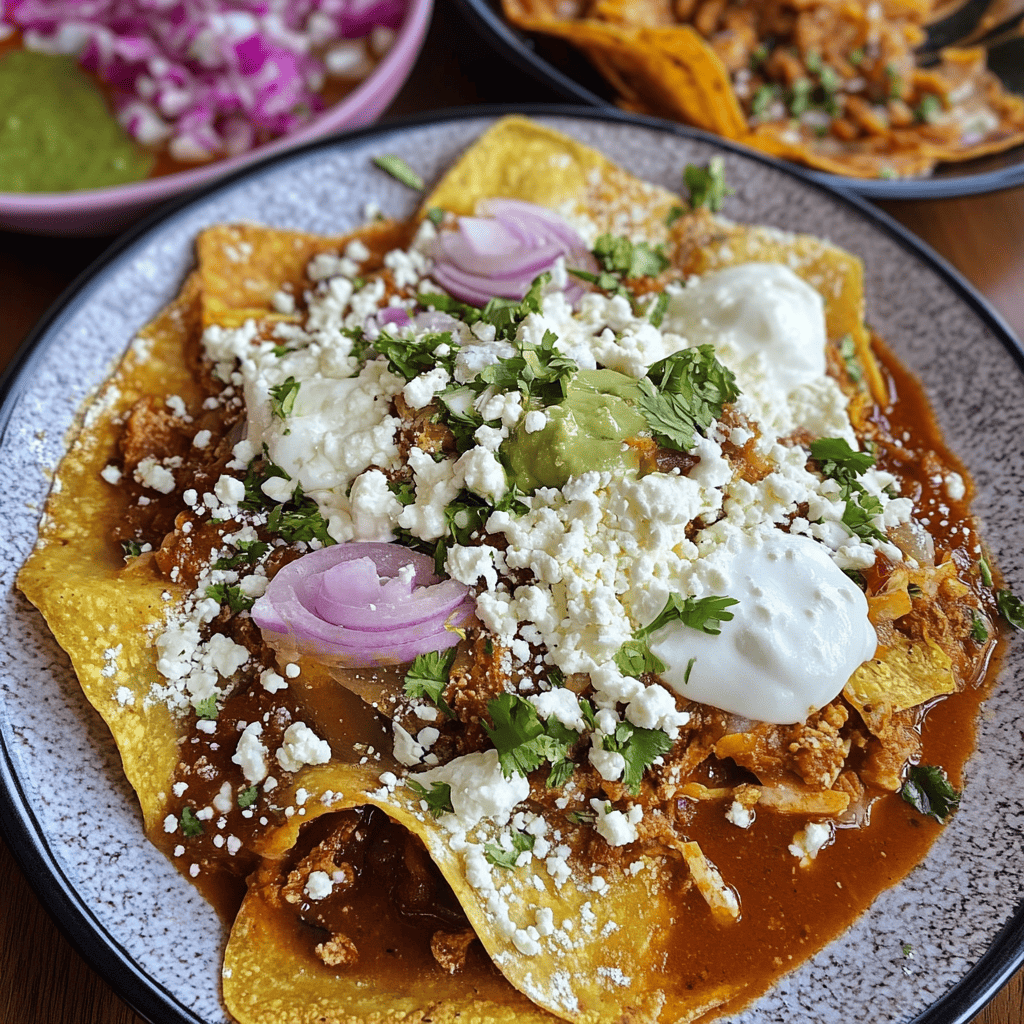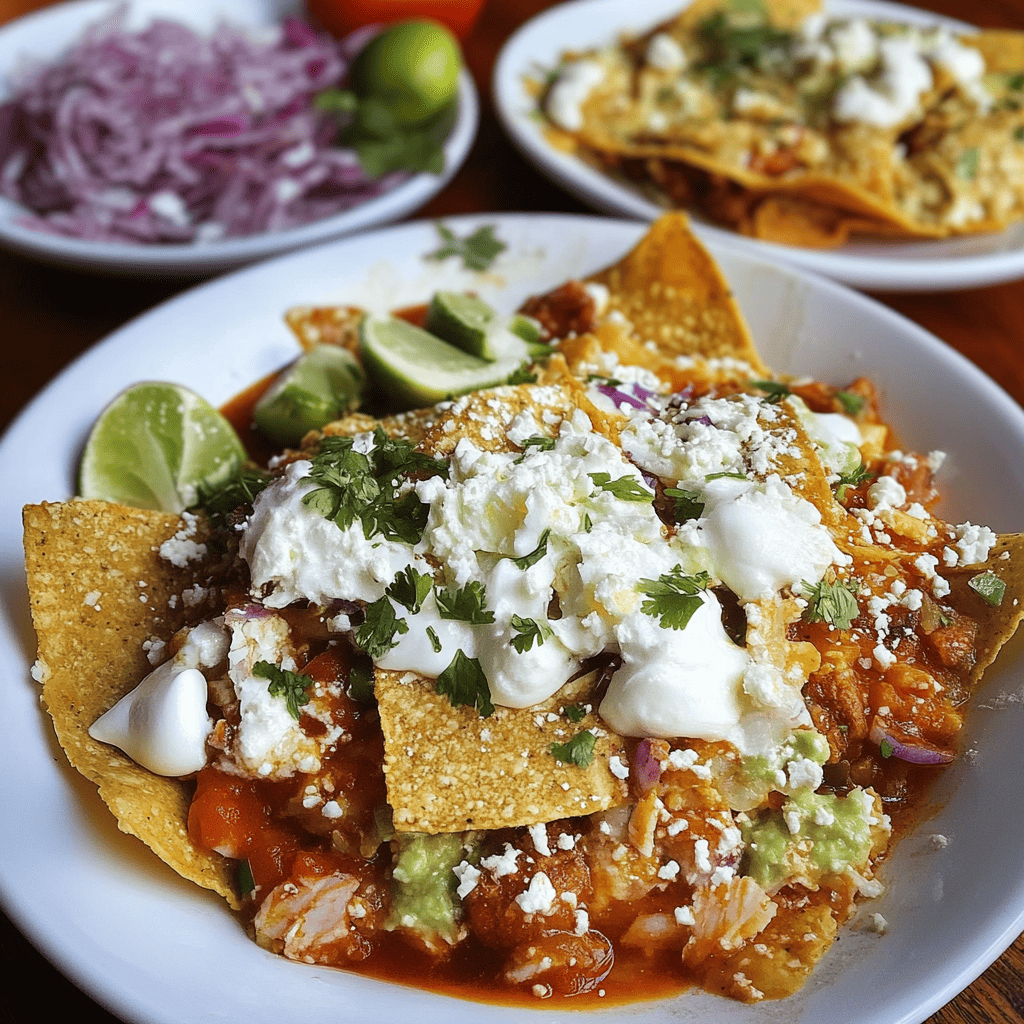Chilaquiles
Chilaquiles: History, Variations and Preparation
Introduction
Chilaquiles are a traditional Mexican dish that has endured through the centuries thanks to their flavor, versatility, and simplicity. They consist of fried corn tortillas or tortilla chips covered in a sauce (red or green) and accompanied by ingredients such as cheese, sour cream, onion, beans, eggs, or shredded chicken .
They’re very popular for breakfast or lunch, as they combine crispy and soft textures with the characteristic spicy kick of Mexican cuisine. They’re also a great way to use up day-old tortillas, making them a sustainable and affordable dish.
Chilaquiles are a traditional Mexican dish known for their simplicity, versatility, and delicious flavor. They are prepared with corn tortillas cut into triangles, fried until crispy, and tossed in a sauce that can be red or green, depending on the ingredients used. They are often served with fresh cheese, sour cream, onion, beans, eggs, or shredded chicken, although there are many variations depending on the region and individual tastes.
This dish is a fundamental part of Mexican cuisine and holds a special place in the country’s culinary culture. Not only is it a common choice for family breakfasts and in restaurants, but it’s also known for being a comforting and affordable meal. Furthermore, chilaquiles represent an ingenious way to use up day-old tortillas, avoiding food waste, demonstrating the creativity and efficiency of Mexican cuisine.
Beyond their importance in everyday life, chilaquiles have transcended Mexico’s borders and gained popularity in other parts of the world, especially in the United States and Spain, where they have been adapted with local ingredients. Thanks to their unique combination of textures, flavors, and the ability to customize them with different ingredients, chilaquiles remain a dish appreciated by people of all ages and tastes.
In this article, we’ll explore the history, variations, and preparation of chilaquiles, as well as their impact on Mexican culinary culture. We’ll also answer key questions about their origins, ingredients, and preparation techniques to understand why this dish remains one of the most beloved and consumed dishes in Mexico and around the world.

History of Chilaquiles
The origin of chilaquiles dates back to pre-Hispanic times. Its name comes from the Nahuatl chīlāquilitl , which means “tortillas in chili.” Mesoamerican cultures often cooked tortillas in different shapes and accompanied them with sauces made with chilies and tomatoes, basic ingredients in the indigenous diet.
With the arrival of the Spanish in the 16th century, new ingredients such as cream, cheese, and meat were introduced, which were eventually incorporated into chilaquiles. Since then, the dish has evolved and adapted to different regions of Mexico, giving rise to multiple variations.
Types and Variations of Chilaquiles
Throughout the country, chilaquiles have acquired different flavors and preparation methods, depending on the local ingredients and traditions of each region.
According to the sauce:
- Red chilaquiles: Made with tomato sauce, guajillo chili, ancho chili, or chipotle. They are sweeter and less acidic than the green ones.
- Green Chilaquiles: Prepared with green tomatillo sauce and serrano or jalapeño chili, they have a more acidic and fresh flavor.
- Chilaquiles in mole: Covered with mole poblano or mole negro, which gives them a deep, spicy flavor.
- Chilaquiles divorciados: Served with red sauce on one half of the plate and green sauce on the other.
According to the accompaniment:
- With egg: They can have fried or scrambled eggs.
- With chicken: Shredded chicken is added for greater consistency.
- With meat: In some regions, they are served with cecina, chorizo or carnitas.
- With beans: They can be accompanied with refried beans or pot beans.
- With cheese and cream: This is the most basic and traditional version.
According to texture:
- Crispy: Serve immediately after adding the salsa to keep the tortilla chips crispy.
- Soft: Let them sit in the sauce until the tortillas are coated and acquire a softer texture.

Preparation of Traditional Chilaquiles
Below is a basic recipe for preparing red and green chilaquiles.
Ingredients:
- 10 corn tortillas cut into triangles
- Vegetable oil (for frying)
- 2 large tomatoes (for red chilaquiles)
- 5 green tomatillos (for green chilaquiles)
- 1 clove of garlic
- 1/4 onion
- 2 serrano chiles (for green sauce) or 2 guajillo/ancho chiles (for red sauce)
- Salt and pepper to taste
- 1/2 cup chicken broth
- 1/2 cup crumbled fresh cheese
- 1/2 cup of cream
- 1/4 sliced red onion
- 1 shredded chicken breast (optional)
- 2 fried eggs (optional)
Preparation:
- Fry the tortillas:
- Heat enough oil in a frying pan and fry the tortilla triangles until golden brown and crispy. Remove them and place them on absorbent paper.
- Prepare the sauce:
- For red chilaquiles , boil the tomatoes with the guajillo chiles and blend with garlic, onion, salt and a little chicken broth.
- For green chilaquiles , boil the tomatillos with the serrano peppers and blend with garlic, onion, salt and chicken broth.
- Cook the sauce:
- Pour the sauce into a pan and cook over medium heat until it boils and thickens slightly.
- Add the tortilla chips:
- Add the fried tortillas to the sauce and mix gently to coat well.
- Serve:
- Place the chilaquiles on a plate and garnish with sour cream, fresh cheese, red onion, and, if desired, shredded chicken or a fried egg.
Cultural Importance and Popularity
Chilaquiles are a staple of Mexican cuisine and are enjoyed throughout the country, from homes to the most sophisticated restaurants. They’re especially popular as a comforting breakfast and are said to help relieve a hangover after a night of partying.
Internationally, chilaquiles have gained recognition in countries like the United States and Spain, where they have been adapted with local ingredients without losing their essence.
Texture and flavor
Chilaquiles offer a unique combination of textures: the totopos (fried or toasted tortilla chips) partially absorb the sauce, remaining soft on the inside and slightly crispy on the outside. The flavor varies depending on the sauce used: green (more acidic and fresh, made with tomatillo), red (more intense, tomato-based), mole (sweet and spicy), or even beans. They are often topped with sour cream, fresh cheese, onion, and sometimes avocado or egg, which adds layers of freshness, creaminess, and a touch of saltiness.
Consumer context
Chilaquiles are a traditional Mexican breakfast, especially popular as a hangover cure due to their comforting and nutritious nature. They are also served as brunch or a light lunch. They are a staple in restaurants, markets, and homes across the country, and many families have their own special version passed down from previous generations. They always find a place as a signature dish at celebrations, buffets, or informal gatherings.
Visual appearance
Visually, chilaquiles are a colorful and appealing dish: tortilla chips covered in salsa are mixed with sour cream, shredded cheese, sliced red onion, fresh cilantro, and sometimes a fried egg on top. The contrasting colors—green, red, white, gold—make them vibrant and appetizing. They are served in bowls, often accompanied by refried beans or fried plantains.
Curiosities
- The name “chilaquiles” comes from the Nahuatl chīlāquilitl , which translates as “herbs or vegetables in chili.”
- It is one of the few Mexican dishes that completely changes its flavor depending on the type of sauce, giving it great versatility.
- In some regions of southern Mexico, they are also prepared with bean sauce.
- They’re a great way to use up day-old tortillas, reflecting the sustainable approach of traditional Mexican cuisine.
- There are gourmet versions served in haute cuisine restaurants with ingredients such as duck confit, goat cheese, or habanero chili sauce.
Estimated nutritional value (per standard serving)
Based on a portion of chilaquiles with green sauce, cream, cheese and egg.
- Calories: 450–550 kcal
- Fat: 25 g
- Protein: 12–15 g
- Carbohydrates: 40–50 g
- Fiber: 4 g
- Sodium: 600–800 mg
- Natural sugars: 3–5 g
Note: Values may vary depending on ingredients, portions and preparation method.
Frequently Asked Questions
Can I use store-bought tortilla chips instead of homemade?
Yes. Although homemade tortilla chips tend to absorb salsa better, store-bought ones also work well, especially if they’re thick and sturdy.
How long can chilaquiles be stored?
Ideally, they should be eaten freshly made. If you have leftovers, keep them refrigerated for up to 24 hours. Reheating them can cause them to lose their texture.
Can they be made vegan?
Of course! Just use animal-free tortilla chips, homemade salsa, eliminate the cheese and sour cream, and add toppings like avocado or cream.
What sauce are they most popular with?
It depends on the region. In central Mexico, green salsa is very common; in other states, red salsa is preferred. In Oaxaca and Puebla, they are sometimes served with mole.
Are they spicy?
They can be, but you control the heat level when making the sauce. You can make a mild version for children or people sensitive to chili.
Other interesting information
- They are ideal for reusing leftovers: tortillas, salsa from the day before, even shredded chicken or roast beef.
- You can customize the toppings according to your preferences: egg, chorizo, steak, nopalitos, Oaxaca cheese, etc.
- In many Mexican families, the quintessential “Sunday breakfast” is chilaquiles, served with fresh orange juice and coffee.

Conclusion
Chilaquiles are a symbol of Mexican cuisine, combining simplicity, tradition, and flavor in a single dish. Their versatility allows everyone to prepare them to their liking, whether with red or green sauce, mole, or various side dishes.
Thanks to their rich history and deep roots in Mexican culture, chilaquiles will continue to be a staple on the tables of many generations.
Chilaquiles are an iconic dish of Mexican cuisine that has endured over time, adapting to different regions and tastes without losing its essence. Their simple preparation, based on the use of basic ingredients like corn tortillas and salsas, demonstrates the creativity and richness of traditional Mexican cuisine. Furthermore, the versatility of this dish allows for multiple variations, from red and green chilaquiles to more innovative options with ingredients like avocado, grilled meat, or even seafood .
Beyond their culinary value, chilaquiles have deep cultural roots. Not only are they a comforting and nutritious breakfast, but they are also present in everyday moments and family celebrations, strengthening Mexico’s culinary identity. Their popularity has transcended borders, establishing themselves as a beloved dish in other countries, where they are reinterpreted with local ingredients.
Nutritionally, chilaquiles can be both a balanced dish and an indulgence, depending on the ingredients and preparation method. While traditionally prepared with fried tortillas, healthier versions exist that use baked tortillas or lower-fat salsa, making this dish accessible to different dietary preferences and needs.
In conclusion, chilaquiles are much more than a simple dish; they represent the history, tradition, and versatility of Mexican cuisine. Their ability to adapt to different styles and palates ensures that they will remain a favorite both in Mexico and around the world. Regardless of the version or side dish chosen, chilaquiles will always offer an authentic and delicious culinary experience, reaffirming their place as one of Mexico’s great culinary treasures.

